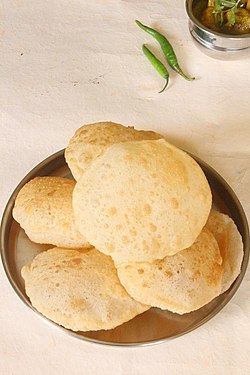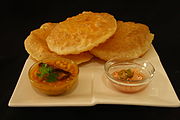
Chapati, also known as roti, rooti, rotee rotli, rotta, safati, shabaati, phulka, chapo, sada roti, poli, and roshi, is an unleavened flatbread originating from the Indian subcontinent and is a staple in India, Nepal, Bangladesh, Pakistan, Kyrgyzstan, Sri Lanka, the Arabian Peninsula, East Africa, and the Caribbean. Chapatis are made of whole-wheat flour known as atta, mixed into dough with water, oil (optional), and salt (optional) in a mixing utensil called a parat, and are cooked on a tava.

Roti is a round flatbread native to the Indian subcontinent. It is commonly consumed in many South Asian, Southeast Asian, Caribbean, Trinidad and Southeast African countries.

Pakistani cuisine can be characterized as a blend of regional cooking styles and flavours from across South, Central and Western Asia. Pakistani cuisine is influenced by Persian, Indian, and Arab cuisine. The cuisine of Pakistan also maintains certain Mughal influences within its recipes and cooking techniques. Pakistan's ethnic and cultural diversity, diverse climates, geographical environments, and availability of different produce lead to diverse regional cuisines.

Bhelpuri is a savoury snack originally from India, and is also a type of chaat. It is made of puffed rice, vegetables and a tangy tamarind sauce, and has a crunchy texture.

Dahi vada is a type of chaat (snack) originating from the Indian subcontinent. It is prepared by soaking vadas in thick dahi (yogurt).
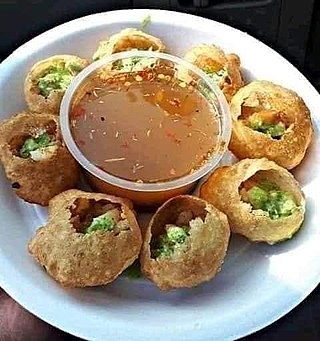
Pani puri is a deep-fried breaded hollow spherical shell, about an inch in diameter, filled with a combination of finely diced potato, onion, peas and chickpea. It is a common street food in the Indian subcontinent. It is often spiced with tamarind chutney, chili powder, or chaat masala. A Bengali variant, fuchka, uses spiced mashed potatoes and dal or ghugni as the filling.

Bhatoora is a fluffy deep-fried leavened sourdough bread originating from the Indian subcontinent. It is commonly served as a midday meal or a breakfast dish in northern and eastern India. Paired with chickpea curry, it forms a traditional dish called chole bhature.

Chaat, or chāt is a family of savoury snacks that originated in India, typically served as an hors d'oeuvre or at roadside tracks from stalls or food carts across South Asia in India, Pakistan, Nepal and Bangladesh. With its origins in Uttar Pradesh, India, chaat has become immensely popular in the rest of South Asia.
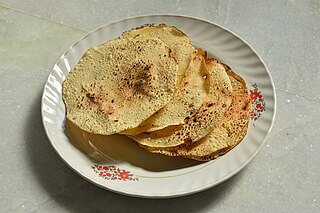
A papadam, also known as papad, is a snack that originated in the Indian subcontinent. Dough of black gram bean flour is either deep fried or cooked with dry heat until crunchy. Other flours made from lentils, chickpeas, rice, tapioca, millet or potato are also used. Papadam is typically served as an accompaniment to a meal in India, Pakistan, Bangladesh, Nepal, Sri Lanka and the Caribbean or as an appetizer, often with a dip such as chutneys, or toppings such as chopped onions and chili peppers, or it may be used as an ingredient in curries.

Doubles is a common street food originating in Trinidad and Tobago with Indian origin. It is normally eaten during breakfast, but is also eaten occasionally during lunch or as a late night snack and popular hangover food for local Trinidadians. Doubles is made with two baras and filled with curry channa and various chutneys.

A flatbread is bread made usually with flour; water, milk, yogurt, or other liquid; and salt, and then thoroughly rolled into flattened dough. Many flatbreads are unleavened, although some are leavened, such as pita bread.

Indian breads are a wide variety of flatbreads and crêpes which are an integral part of Indian cuisine. Their variation reflects the diversity of Indian culture and food habits.

Dahi puri is an Indian snack food which is especially popular in the state of Maharashtra. The dish is a type of chaat and originates from the city of Mumbai. It is served with mini-puri shells (golgappa), which are also used for the dish pani puri. Dahi puri and pani puri chaats are often sold by the same vendor.
Bhojpuri cuisine is a style of food preparation common among the Bhojpuri people of Bihar and eastern Uttar Pradesh in India, and also the Terai region of Nepal. Bhojpuri foods are mostly mild and tend to be less hot in terms of spices used. The cuisine consists of both vegetable and meat dishes.

Chole bhature is a food dish popular in the northern areas of the Indian subcontinent. It is a combination of chana masala and bhatura/puri, a deep-fried bread made from maida.
Cuisine of Uttar Pradesh is from the state of Uttar Pradesh (UP) located in Northern India. The cuisine of UP has a large variety of dishes. The cuisine consists of both vegetarian and non-vegetarian dishes of different varieties. Being a large state, the cuisine of UP share lot of dishes and recipes with the neighboring states of Delhi, Uttarakhand, Bihar, Jharkhand and Haryana. Apart from native cuisine, Mughlai, Awadhi and Bhojpuri are famous subtypes of cuisine of the state.
Awadhi cuisine is a cuisine native to the Awadh region in Northern India and Southern Nepal. The cooking patterns of Lucknow are similar to those of Central Asia, the Middle East, and Northern India and western India with the cuisine comprising both vegetarian and non-vegetarian dishes. The Awadh region has been influenced by Mughal cooking techniques, and the cuisine of Lucknow bears similarities to those of Central Asia, Kashmir, Punjab and Hyderabad. The city is also known for its Nawabi foods.

Malaysian Indian cuisine, or the cooking of the ethnic Indian communities in Malaysia, consists of adaptations of authentic dishes from India, as well as original creations inspired by the diverse food culture of Malaysia. Because the vast majority of Malaysia's Indian community are of South Indian descent, and are mostly ethnic Tamils who are descendants of immigrants from a historical region which consists of the modern Indian state of Tamil Nadu and Sri Lanka's Northern Province, much of Malaysian Indian cuisine is predominantly South Indian inspired in character and taste. A typical Malaysian Indian dish is likely to be redolent with curry leaves, whole and powdered spice, and contains fresh coconut in various forms. Ghee is still widely used for cooking, although vegetable oils and refined palm oils are now commonplace in home kitchens. Before a meal it is customary to wash hands as cutlery is often not used while eating, with the exception of a serving spoon for each respective dish.
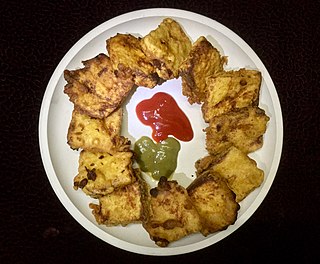
Bread pakora is an Indian fried snack. It is also known as bread bhaji. A common street food, it is made from bread slices, gram flour, and spices among other ingredients.
